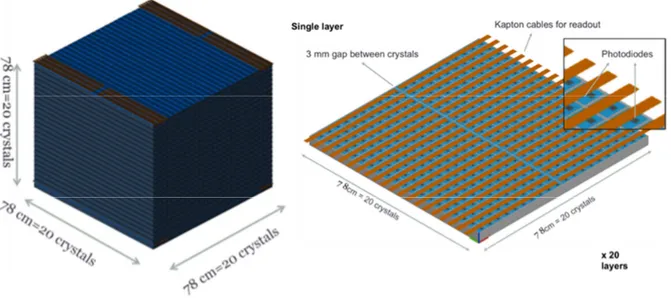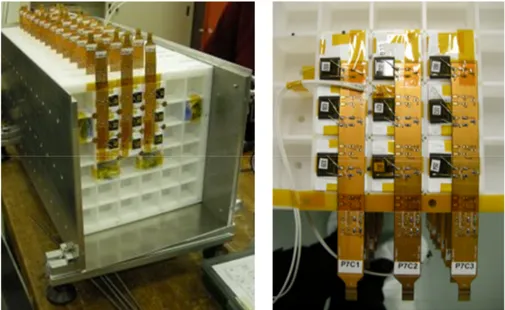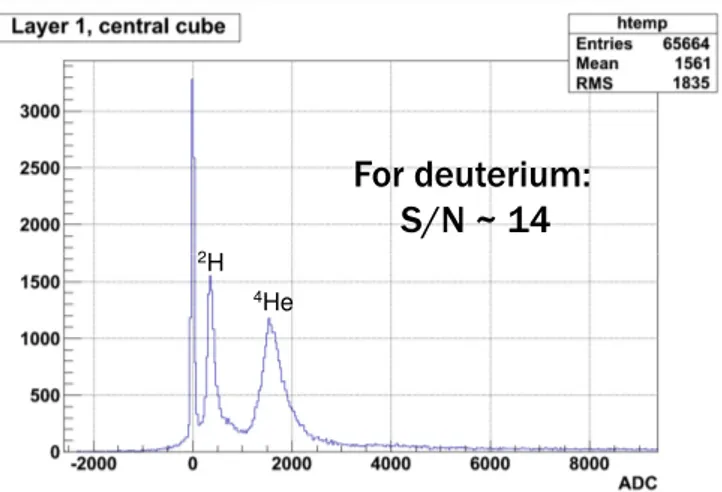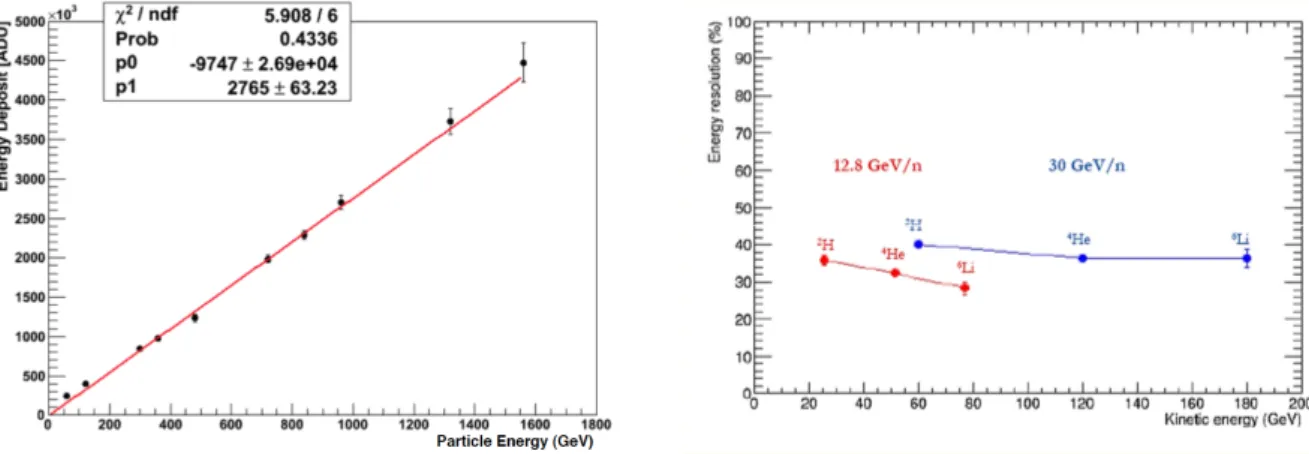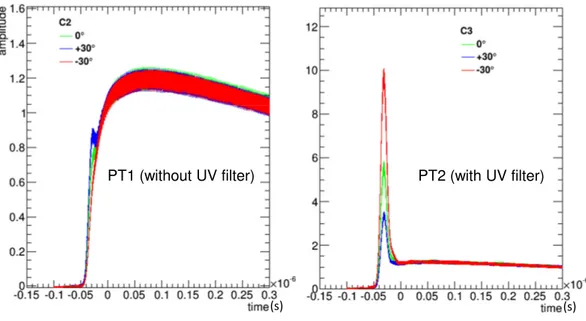Download details:
IP Address: 193.205.6.111
This content was downloaded on 25/02/2015 at 10:39
Please note that terms and conditions apply.
View the table of contents for this issue, or go to the journal homepage for more 2015 J. Phys.: Conf. Ser. 587 012029
CALOCUBE: an approach to high-granularity and
homogenous calorimetry for space based detectors
M Bongi1,2, O Adriani1,2, S Albergo3,4, L Auditore5,6, M G Bagliesi7,8, E Berti1,2, G Bigongiari7,8, M Boezio9, L Bonechi2, S Bonechi7,8, V Bonvicini9, S Bottai2, P Brogi7,8, G Carotenuto10, A Cassese2,11, G Castellini11, P W Cattaneo12, D Cauz9,13, P Cumani9,14,
R D’Alessandro1,2, S Detti2, M Fasoli15, A Gregorio9,14, A Lamberto5,6, P Lenzi2, P Maestro7,8, P S Marrocchesi7,8,
A Mezzasalma5,6, M Miritello16, N Mori1,2, P Papini2, G Pauletta9,13, G F Rappazzo4,5, A Rappoldi12, S Ricciarini2,11, P Spillantini1,2, O Starodubtsev1,2, A Sulaj7,8, A Tiberio1,2, A Trifir`o5,6,
M Trimarchi5,6, E Vannuccini2, A Vedda15, G Zampa9, N Zampa9 and
B Zerbo4
1 University of Florence, Department of Physics and Astronomy, via G. Sansone 1, I-50019
Sesto Fiorentino (Firenze), Italy
2
INFN Firenze, via B. Rossi 1, I-50019 Sesto Fiorentino (Firenze), Italy
3 University of Catania, of Physics and Astronomy, via S. Sofia 64, I-95123 Catania, Italy 4
INFN Catania, via S. Sofia 64, I-95123 Catania, Italy
5 University of Messina, Department of Physics, sal. Sperone 31, I-98166 Messina, Italy 6
INFN Messina, sal. Sperone 31, I-98166 Messina, Italy
7 University of Siena, Department of Physical Sciences, Earth and Environment, I-53100
Siena, Italy
8 INFN Pisa, via F. Buonarroti 2, I-56127 Pisa, Italy 9
INFN Trieste, via Valerio 2, I-34127 Trieste, Italy
10
Institute for Polymer, Composites and Biomaterials (CNR), piazzale E. Fermi 1, I-80055 Portici (Napoli), Italy
11
IFAC (CNR), via Madonna del Piano 10, I-50019 Sesto Fiorentino (Firenze), Italy
12INFN Pavia, via A. Bassi 6, I-27100 Pavia, Italy 13
University of Udine, Department of Chemistry, Physics and Environment, via delle Scienze 206, I-33100 Udine, Italia
14
University of Trieste, Department of Physics, via Valerio 2, I-34127 Trieste, Italy
15
University of Milano-Bicocca, Department of Materials Science, via Cozzi 55, I-20125 Milano, Italy
16
MATIS (CNR), via S. Sofia 64, I-95123 Catania, Italy E-mail: [email protected]
Abstract. Future space experiments dedicated to the observation of high-energy gamma and cosmic rays will increasingly rely on a highly performing calorimetry apparatus, and their physics performance will be primarily determined by the geometrical dimensions and the energy resolution of the calorimeter deployed. Thus it is extremely important to optimize its geometrical acceptance, the granularity, and its absorption depth for the measurement of the particle energy with respect to the total mass of the apparatus which is the most important constraint for a space launch. The proposed design tries to satisfy these criteria while staying within a total mass budget of about 1.6 tons. Calocube is a homogeneous calorimeter instrumented with Cesium iodide (CsI) crystals, whose geometry is cubic and isotropic, so as to detect particles
1. Introduction
Calocube is a project funded by the Italian National Institute for Nuclear Physics (INFN) for the study of a calorimeter with an innovative design, whose characteristics make it very appealing for next-generation space experiments dedicated to the investigation of high-energy cosmic rays. Its scientific goal is the measurement of the energy spectrum of the nuclear component of cosmic rays in the region of the knee (E ∼ 1015 eV), where the spectral index shows a significant change, and of the electromagnetic component above the TeV region. The main issues for these kind of measurements are the steep fall of the spectrum with increasing energy, which makes large acceptance (> 3 m2sr) a necessary requirement, and the dominant proton background, which requires a very good hadron/electron rejection power (> 105) for the identification of electromagnetic particles. In order to reveal possible structures in the spectrum, a further requirement is an excellent energy resolution both for the electromagnetic component (∼ 1% − 2%) and for the hadronic one (< 30%).
The geometrical acceptance of conventional cosmic-ray telescopes is limited by their ability to detect only particles impinging on one face of the apparatus. The peculiarity of the design of Calocube is its capability of detecting particles coming from any direction, and not only those on its upper surface. To ensure that the quality of the measurement does not depend on the arrival direction of the particles, the calorimeter will be designed as homogeneous and isotropic as possible. In addition, to achieve a high discrimination power for hadrons and nuclei with respect to electrons, the sensitive elements of the calorimeter need to have a fine 3-D sampling capability which can be used to analyze the topological differences in the development of electromagnetic and hadronic showers. Finally, to improve the energy resolution for hadronic showers we plan to study advanced compensation techniques that rely both on the measurement of the fraction of electromagnetic energy of the shower through the detection of the Cherenkov light, and on the detection of neutrons which are produced in hadronic interactions within the shower. A further key point of the instrument is the capability of directly measure the charge Z of the incident particle, allowing a complete measurement of the cosmic ray spectra without any need of additional dedicated detectors, hence greatly simplifying the structure and reducing power consumption and weight. Most of the above requirements are shared by homogenous hadronic calorimeters for future collider experiments and the development of Calocube could contribute to the optimization of the advanced compensation and leakage-correction techniques which are of common interest.
2. The Calocube detector
As a starting point for the optimization of the design of the detector, a geometry consisting of a cubic matrix made up by cubes of sensitive material has been studied (see Fig. 1). The calorimeter is composed by 20 planes (78 × 78 × 4 cm3), each consisting of 20 × 20 cubic Tallium-activated Cesium iodide (CsI(Tl)) scintillating crystals. The dimensions of the crystals (3.6× 3.6 × 3.6 cm3) are chosen to match the Molie`re radius of the material of the calorimeter, in order to optimize the e/h rejection power. CsI(Tl) has been selected because of the very
CALOR2014, Giessen, 8thApril 2014
CALOR2014, Giessen, 8thApril 2014
Figure 1. Conceptual design of the 3-D highly-segmented calorimeter. The left panel depicts the complete cubic detector, while in the right panel some details about a single plane are shown.
high light yield (54000 ph/MeV) and because of its intermediate density (4.5 g/cm3), which allows to reach a very large geometric factor with an acceptable overall mass (1683 kg of active material in this configuration). The distance between the crystal has been tuned to a 3-mm gap in order to maximize the acceptance without any significant degradation of the performance of the calorimeter. The very large depth of the calorimeter (39 X0, 1.8 λI for vertically incident particles) allows a complete containment of the electromagnetic showers up to the highest energies, and the measurement with high efficiency of the hadronic particles up the PeV region. A total of 8000 crystals will be used for the whole calorimeter assembly. This geometry has no privileged direction, thus achieving performances that are independent of the direction of incidence of the particle. The high granularity in every direction provides accurate information regarding the formation of the shower inside the device. This information could be exploited to distinguish electrons from hadrons and to help correcting for the lack of containment.
To cover the huge required dynamic range (from≤ 1 MIP for non interacting protons, useful for calibration purposes, up to 107 MIPs in one single crystal for PeV interacting hadrons) the photosensors and the readout electronics must be carefully chosen and designed. In the basic design of the apparatus the scintillation light produced in one crystal is read out with two different photodiodes, one with larger area (9.2 × 9.2 mm2 in the present design) for the low energy particles, and one with smaller area (0.5× 0.5 mm2) for the highest energy particles. Rows of flat kapton cables are used to extract signals from the calorimeter (see Fig. 1). To make optimal use of the excellent linearity of the photodiodes, a front-end chip with a large dynamic range is mandatory. In our proposal we have selected the CASIS chip [1], that has been specifically developed by INFN Trieste for calorimetric space applications. Every chip consists of 16 independent channels, with a charge sensitive amplifier and a correlated double sampling system, with automatic switching between two different gains, depending on the injected charge. The small power consumption of a single channel (2.8 mW), associated with the low noise (3000 e−for 100 pF input capacitance) and the large maximum input charge (53 pC) are perfectly suited for the Calocube design. By properly combining the dual gain of
CALOR2014, Giessen, 8thApril 2014
CALOR2014, Giessen, 8thApril 2014
Figure 2. Left panel: picture of the 126-crystals Calocube prototype. Right panel: detail of a single layer, showing the 9 large area photodiodes placed on the crystals, that are wrapped in white teflon tape, and the kapton cables used to read-out the signals.
the chip and the pair of photodiodes connected with a single crystal, we can efficiently cover the whole required dynamic range.
The performance of the detector in this configuration have been estimated from a detailed Monte Carlo simulation based on the FLUKA package [2]. The resulting geometric factor when accepting particles from 5 sides is about (1.91 m2sr× 5) = 9.55 m2sr, while an electromagnetic energy resolution better than 2% for TeV particles and a hadronic energy resolution ∼ 35% for 1-100 TeV protons can be expected (using the scintillation light output only), with an effective geometric factor of about 3-4 m2sr. Further details about the Monte Carlo studies can be found in ref. [3].
3. SPS test on the Calocube 126-crystals prototype
In parallel to simulation studies, prototype construction and testing activities have been carried out. A matrix of 126 CsI(Tl) crystals (14 layers, 3× 3 crystals per layer) has been assembled in a modular mechanical structure (see Fig. 2). Each crystal was coupled with a large area 9.2× 9.2 mm2Excelitas VTH2090 photodiode which ensures a linear response in the range from 0.3 to 104 MIP, and 9 CASIS chips have been used for the readout.
This prototype has been tested on high-energy particle beams at the CERN SPS accelerator facility in February 2013. Ions with A/Z=2 and 30 GeV/n and 12.8 GeV/n have been used to characterize the front-end electronics and to study the performance of the calorimeter. The excellent low-noise performance obtained can be seen from the plot in Fig. 3 that shows a very good separation of the 2H and 4He peaks observed in the first layer of the prototype, as well as a clear separation of the 1 MIP signal from the pedestal value. The non-interacting Deuterium peak can be resolved with a S/N ∼ 14. A preliminary study of the capability of this kind of calorimeter as a charge detector is reported in Fig. 4. The left plot shows the energy deposited in the central crystal of the first layer for a sample of events which have not suffered an inelastic interaction in the first two layers (∼ 0.2 λI). These events have been selected by requiring that the signals in the two layers are consistent with the dE/dx of a fully stripped ion
CALOR2014, Giessen, 8thApril 2014
CALOR2014, Giessen, 8thApril 2014
NON INTERACTING IONS: SIGNAL/NOISE
2H 4He
For deuterium:
S/N ~ 14
27
Figure 3. Signal (ADC units) of non-interacting 30 GeV/n 2H and 4He detected in the first layer of the calorimeter prototype.
heavier nuclei up to sulphur (Fig. center) were tagged by means of an array of
silicon pixel and micro-‐strip sensors positioned upstream the calorimeter. The mean
signal value of each nucleus scales linearly with Z
2(Fig. right) up to Z=12, while
saturation effects begin to occur for Z>12. The charge separation is quite poor
(worse than 0.3e in the BCNO region) compared to the typical performance of a
charge detector. However these results are encouraging, considering that the
instrument prototype was not optimized for this purpose; they suggest that the PID
capability could be improved with a different configuration of sensitive elements on
the faces of the calorimeter.
We propose to study a possible replacement of each crystal cube on the faces of the
calorimeter with a stack of thinner scintillating squared tiles in order to perform
multiple measurement of dE/dx of the incident CR nucleus. This configuration might
allow to identify the charge of the CR particle with the required resolution before
the first inelastic interaction in the calorimeter occurs.
Moreover a fine dE/dx sampling could be used to tag CR particles undergoing
spallation reactions in the charge identifier itself. These represent a dangerous
background and may induce significant systematic errors in the measurement of
secondary-‐to-‐primary abundances in CRs (e.g. B/C, sub-‐Fe/Fe ratios), when not
properly identified and corrected. The correlation of dE/dx signals from consecutive
tiles would be a powerful tool to identify nuclei interacting in the detector material
and allowed to reject them in the data analysis.
Finally, the intrinsic pixel geometry of the tile array would allow to isolate the
ionization signal generated by the incoming particle, reducing the effect of back-‐
scattered shower particles, thereby minimizing the probability of misidentification.
The CIS configuration and design will be optimized by means of detailed Monte
Carlo simulations (as described in WP2) in order to achieve single-‐element
discrimination and reduce the probability of fake charge identification induced by
backscattered shower particles from the calorimeter.
The final goal is to build an innovative charge detector with comparable
performance to a silicon pixel array but based on an easier and cheaper technology.
The integration with the calorimeter would allow to develop a common R&D
program for the sensors and readout electronics.
Figure 4. Preliminary results showing the charge identification capabilities of the calorimeter prototype. Left panel: energy deposited in the central crystal of the first layer for a sample of non-interacting ions. Right panel: sample of high-Z events whose charge has been selected by a precise low-thickness silicon tracker located upstream of the prototype, providing a high-purity charge tagging by means of 12 independent dE/dx measurements.
of charge Z. The pulse height distributions corresponding to nuclei from Deuterium to Oxygen are clearly visible. High-purity samples of heavier nuclei up to Sulphur were tagged by means of an array of silicon pixel and microstrip sensors positioned upstream the calorimeter, as shown in the right plot of Fig. 4. Even though the charge separation is quite poor (worse than 0.3e in the BCNO region) compared to the typical performance of a charge detector, these results are encouraging, considering that the instrument prototype was not optimized for this purpose and the identification capabilities can be improved with a different configuration of sensitive elements on the faces of the calorimeter.
A first glance at the performance in the large energy release region can be obtained from the left plot of Fig. 5, which shows a good linearity in the response of the prototype from the low-Z (2H) up to the high-Z ions (Fe). The right panel of Fig. 5 shows a preliminary estimate
Figure 3: Non-interacting 30 GeV/n2H and4He observed in the first layer of the prototype.
A first glance at the performance in the large energy release region can be obtained from Fig.4,
which shows a good linearity in the prototype’s response from the low Z particles (2H) up to the
high Z particles (Fe).
Figure 4: Linearity of the prototype’s response for the various ion species, for the SPS ion beam with A/Z=2 and 30 GeV/n (preliminary). D, He, B, C, O, Mg, SI, S, Ti and Fe nuclei have been selected by a precise low-thickness silicon tracker located upstream of the prototype, providing a high purity charge tagging by means of 12 independent dE/dx measurements of the incoming beam particle.
458
CALOR2014, Giessen, 8thApril 2014 CALOR2014, Giessen, 8thApril 2014
Figure 5. Left panel: preliminary result showing the linearity of the response of the prototype to the 30 GeV/n beam as a function of the energy of the various A/Z=2 ions. D, He, B, C, O, Mg, Si, S, Ti and Fe nuclei have been selected by the external silicon tracker. Right panel: preliminary estimate of the energy resolution of the prototype for showers starting on the second layer as a function of the energy of the incoming ion (the error bars refer to statistical errors only and further analysis work is in progress to assess the systematic uncertainties).
of the energy resolution of the prototype as a function of the energy of incoming interacting nuclei. Events with showers starting on the second layer of the calorimeter are selected in order to ensure a good longitudinal containment.
4. BTF tests on crystals for dual readout
The limitations imposed by the use of this kind of instrument in a space experiment drastically restrict its weight and size, making it impossible to build a total containment hadronic calorimeter. The energy resolution is therefore dominated by longitudinal losses which, because of the intrinsic fluctuations between the electromagnetic and the hadronic components during the development of the shower, cause large fluctuations in the amount of detected energy. To partially compensate for the effect of the fluctuations, a line of development of the Calocube project pursues the possibility to detect simultaneously the scintillation and the Cherenkov light, which carry information on the different components of the shower. In this context, an activity of characterization of the optical properties of CsI(Tl) crystals and other scintillating materials to optimize their application for a dual readout technique is currently underway: the possibility to improve transparency and emission efficiency by adjusting the concentration of the doping impurities is also being considered.
Some of the features of the Cherenkov light that can be used to discriminate it from the scintillation light are its prompt emission and its rapidly decreasing spectrum with increasing wavelength, which basically makes it detectable in the UV band. Accordingly, we are investigating different choices of light collection and detection systems. These include optical surface treatments of the scintillating material in order to better collect/convert the UV Cherenkov light, such as the deposition of thin wavelength shifter layers directly on the crystals, or the use of suitably engineered nanomaterials to act as dichroic filters.
Preliminary tests with single crystals have been done in September 2013 at the Beam Test Facility (BTF) of the DAFNE accelerator of the INFN Frascati National Laboratory. Several combinations of scintillating crystals (PWO, BSO, CsI(Tl)) and wrapping materials (white teflon, black teflon, mylar) have been exposed to a beam of electrons with E = 500 MeV. Crystals were mounted on a circular platform that could be rotated with respect to the beam
16th International Conference on Calorimetry in High Energy Physics (CALOR 2014) IOP Publishing
Journal of Physics: Conference Series 587 (2015) 012029 doi:10.1088/1742-6596/587/1/012029
phototubes, both with UV filters (DREAM-like)
+30° PT2 PT1 PT1 -30° PT2Figure 6. Setup of the test beam at BTF. The circular platform supporting the crystal could be rotated by±30◦ with respect to the incoming beam line (indicated by an arrow). Two detectors (PT1 and PT2) mounted on opposite sides of the scintillator collected the scintillation and the Cherenkov light.
PT1 (without UV filter) PT2 (with UV filter)
(s) (s)
Figure 7. Preliminary results showing the possibility to extract the Cherenkov signal from the CsI(Tl) crystals. The plots show the time profile of the signals of the two phototubes for the three different incidence angles described in Fig. 6.
line, in order to study the angular dependance of the light output; signal were read out by a couple of sensors placed on opposite sides of the crystals (see Fig. 6). As an example, the plots in Fig. 7 shows preliminary results for the time profile of the signal, averaged over many events, obtained from a 3.6 cm CsI(Tl) cube wrapped in black teflon and read by two Hamamatsu R8900 series phototubes with a 23.5× 23.5 mm2 effective area for three different incidence angles. The phototube PT1 received directly the light produced in the crystal (left plot), while on PT2 a UG11 UV transmitting filter was applied (right plot). While the response of PT1 is nearly independent from the incidence angle, as expected for the scintillation component, the signal collected by PT2 shows clearly a fast peak whose intensity is larger when the phototube is placed downstream the incoming particle with respect to the crystal. The results seem to indicate that it is possible to use the directional and timing characteristics of emitted light to disentangle the Cherenkov signal from the scintillation in CsI(Tl).
separation, as well as in the energy resolution both for electromagnetic and hadronic particles. Preliminary results of a test beam with a prototype of the apparatus show good performances both in the energy measurement and in the charge discrimination capabilities. Studies of the applicability of dual redout techniques to enhance the hadronic performances are in progress and a test beam with single crystals indicate the possibility to successfully use the Cherenkov light emission.
References
[1] Bonvicini V et al. 2010 IEEE Trans. Nucl. Sci. 57 2963–70 [2] Battistoni G at al. 2007 AIP Conf. Proc. 896 31–49
Ferrari A at al. 2005 CERN-2005-10, INFN/TC 05/11, SLAC-R-773 [3] Mori N et al. 2013 Nucl. Instr. Meth. A 732 311-5
